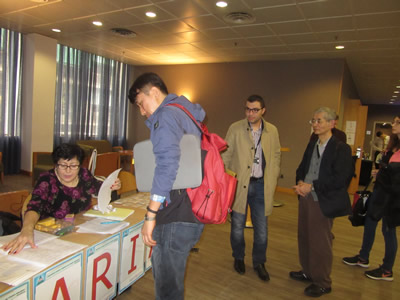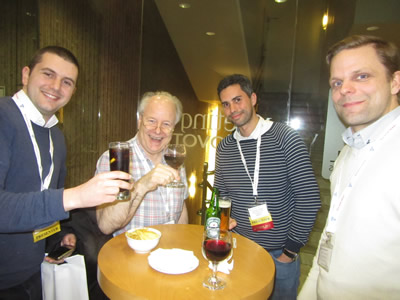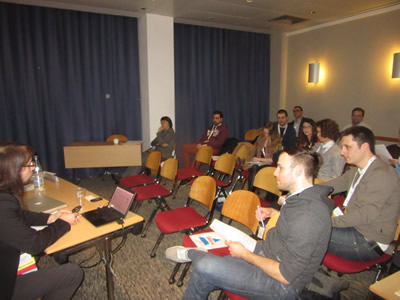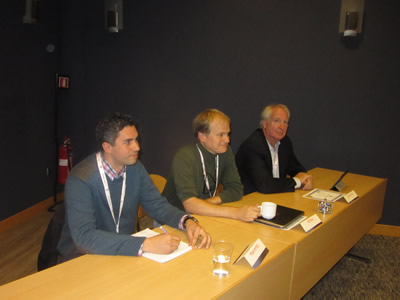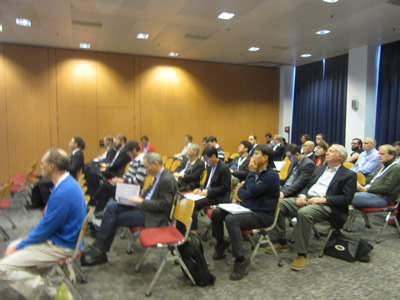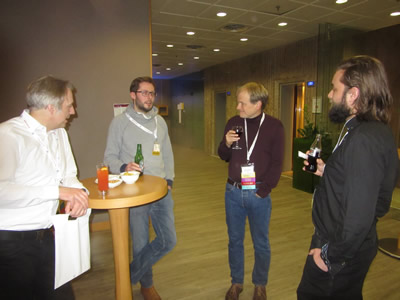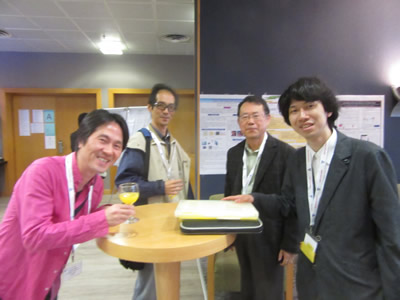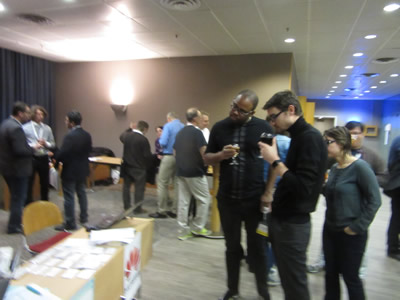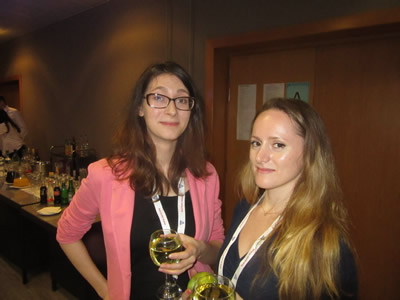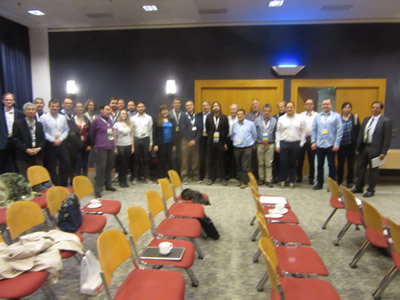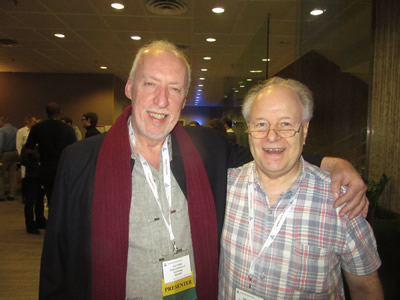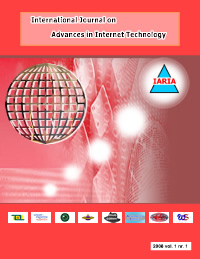ICDS 2019 - The Thirteenth International Conference on Digital Society and eGovernments
February 24, 2019 - February 28, 2019
ICDS 2019: Call for Papers
Nowadays, most of the economic activities and business models are driven by the unprecedented evolution of theories and technologies. The impregnation of these achievements into our society is present everywhere, and it is only question of user education and business models optimization towards a digital society.
Digital devices conquer from kitchen to space vessels most of the functionality commonly performed by human beings. Telecommunications, advanced computation, miniaturization, and high speed devices make telepresence-presence easy. Wireless and mobility allow ubiquitous systems to be developed. Progress in image processing and exchanging facilitate e-health and virtual doctor teams for patient surgeries.
Naturally, issues on how to monitor, control and manage these systems become crucial to guarantee user privacy and safety. Not only devices, but also special software features must be enforced and guaranteed in a digital society.
The variety of the systems and applications and the heterogeneous nature of information and knowledge representation require special technologies to capture, manage, store, preserve, interpret and deliver the content and documents related to a particular target.
In response to this challenge, Intrusion Prevention and Detection Systems have now grown in prominence to such an extent that they are now considered a vital component for any enterprise organisation serious about network defence. However the numerous recorded attacks against high profile organizations is continuing evidence that many of these controls are not, at present, a panacea for dealing with the threats. Having themselves learnt the mechanisms employed by IPDS malicious parties are becoming particularly adept at evading them through inventive obfuscation techniques. These challenges need to be addressed using increasingly more innovative, creative and measurable IPDS mechanisms and methods.
Progress in cognitive science, knowledge acquisition, representation, and processing helped to deal with imprecise, uncertain or incomplete information. Management of geographical and temporal information becomes a challenge, in terms of volume, speed, semantic, decision, and delivery.
Information technologies allow optimization in searching an interpreting data, yet special constraints imposed by the digital society require on-demand, ethics, and legal aspects, as well as user privacy and safety.
Nowadays, there is notable progress in designing and deploying information and organizational management systems, experts systems, tutoring systems, decision support systems, and in general, industrial systems.
The progress in difference domains, such as image processing, wireless communications, computer vision, cardiology, and information storage and management assure a virtual team to access online to the latest achievements.
Processing medical data benefits now from advanced techniques for color imaging, visualization of multi-dimensional projections, Internet imaging localization archiving and as well as from high resolution of medical devices.
Collecting, storing, and handling patient data requires robust processing systems, safe communications and storage, and easy and authenticated online access.
National and cross-national governments' decisions for using the digital advances require e-Government activities on developmental trends, adoption, architecture, transformation, barrier removals, and global success factors. There are challenges for government efficiency in using these technologies such as e-Voting, eHealth record cards, citizen identity digital cards, citizen-centric services, social e-financing projects, and so on.
The Twelfth International Conference on Digital Society and eGovernments
(ICDS 2019) continues a series of international events covering a large spectrum of topics related to advanced networking, applications, and systems technologies in a digital society.
We solicit both academic, research, and industrial contributions. We welcome technical papers presenting research and practical results, position papers addressing the pros and cons of specific proposals, such as those being discussed in the standard fora or in industry consortia, survey papers addressing the key problems and solutions on any of the above topics short papers on work in progress, and panel proposals.
Industrial presentations are not subject to the format and content constraints of regular submissions. We expect short and long presentations that express industrial position and status.
Tutorials on specific related topics and panels on challenging areas are encouraged.
The topics suggested by the conference can be discussed in term of concepts, state of the art, research, standards, implementations, running experiments, applications, and industrial case studies. Authors are invited to submit complete unpublished papers, which are not under review in any other conference or journal in the following, but not limited to, topic areas.
All topics and submission formats are open to both research and industry contributions.
ICDS 2019 conference tracks:
Trends in government-related actions
Smart Cities; Smart Nations; Citizen-centric projects and decisions; Citizen participation in digital government; Usable climate and awareness information; Models for public services; Social media; Social tweeting; ePetitions; eJustice reforms; eParticipation; eGovernment 4.0; Collaborative governance; Digital era governance; Co-creation and co-production of public services; Smart urbanity; e-Ticketing systems; Global and local sustainability; Digital economic strategies; Cybersecurity portals; Transparency and public participation; Metrics for local government responsiveness; Public-private partnerships; Free-access digital libraries; Facebook privacy; Censorship; Web-scale eGovernment recommendation services; Novelty versus social impact; Demographic estimates for urban planners; Citizen-centric maps adaptation (floods, evacuation, emergency, parks, seismic areas, public spaces, etc.); Time-dependent citizen-centric facilities (ambulance spots, firefight stations, etc.); eGovernment solutions and political polarization
Trends in IT related governmental/public services
Citizen-centric government IT planning; Smart Cities High Technology; Internet of Things (IOT) Intelligent Cities; Urban computing; Traffic/congestion prediction systems (cars, pedestrians, bicyclists); Online ride-sharing systems; Intelligent transport urban systems; Monitoring urban resources (hospitals, schools, water, gas, electricity, parks, etc.); Digital health systems; Smart wearable and portable devices; Smartphones and the digital divide; Crowd mobility metrics and patterns; Elderly-oriented services; Big data for digital government; Open government data; Government datasets; Anonymity and de-anonymization; Privacy in medical tests and personalized medicine; Systems and assistive technologies; Real-time platforms for community communications (portals, radio and TV local stations, etc.); IT systems to advertize risks and uncertainty; IT citizen-centric for noise and pollution; Personalized route planning systems; Ambient street displays; IT ethics in online environments
Digital society and robots
Ethics in autonomous and intelligent systems; Interactive robots and interactive humans-robots; City service robots; Integrative social robotics; Social practices for social robotics; Post-robotics; Regulations on Robotics; Robotic legal-decisions; Assistive robotics; Android robotics; Robophilosophy; Moral robots; Military robotics; Cross-Cultural and Trans-disciplinary robotics
eGovernment services in the context of digital society
e-Government strategies; Citizen-Government eModels; Special applications and services of eGovernment; ePayment, eTax administration; eVoting, eCitizen identity cards; Social e-financial projects; Educating eHealth; Homeland security and public records; eGarbage collection of private records; Metrics for eGovernment projects and services; Benefits of eGovernment; On-line social networking; Financing e-Government; e-Governance; From e-Government to m-Government (mobile-Government); e-Environment
Digital accessibility
Design approaches, techniques, and tools to support Web accessibility; Best practices for evaluation, testing reviews and repair techniques; Accessibility across the entire system lifecycle; Accessibility within e-organizations: good practices and experiences; Industry and research collaboration, learning from practice, and technology transfer; Mobile Internet-Web Accessibility; Developing user interfaces for different devices; Dealing with different interaction modalities; Web authoring guidelines and tools; Accessibility and other core areas related to the Web user experience; (UX): Usability, Findability, Valuability, Credibility, etc.; Innovations in assistive technologies for the Web; Accessible graphic formats and tools for their creation; Adaptive Web accessibility; Accessibility and information architecture; Universally accessible graphical design approaches; User Profiling; Cognitive and behavioral psychology of end user experiences and scenarios
Citizen-centric disruptive and enabling technologies
Wireless and user mobility; Ubiquitous systems; On-line interactions; User-centric services, applications, eLearning; High speed electronics, storage, networking eHealth and nano medicine; Biological informatics and computing
Internet and Web services
IP-based networking and applications; Best effort and QoS/SLA; WWW, Web Services, Semantic Web; eLearning and mobile learning; Service-oriented platforms; Peer-to-Peer Systems and applications; Web-advertising and Web-publishing Multimedia and Webcasting
eCommerce and eBusiness
On-line shopping frameworks; Trust, privacy, security; Internet macro and micro payment systems; On-line banking; Agent-based e-commerce; eBusiness models and costs; eBusiness applications; Infrastructure for e-Commerce; Mobile commerce
Citizen-oriented digital evidence
Processing citizen-oriented electronic evidence (acquisition, preservation, analysis); Multimedia documents ( X-rays, radiology, biometrics, and surveillance data); Medical digital forensics; Classic and 3D medical documents; DNA profiling; Genetic and biocomputing; Forensic and data mining; Predictive data modeling; Biological data and privacy; Digital forensics tools
Consumer-oriented devices and services
Mobile TV and IPTV; Consumer-oriented e-commerce; Smart and digital homes; Wearable devices; Smart consumer appliances; Speech enable appliances; Consumer accessibility appliances and services
Intelligent computation
Theories of agency and autonomy; Intelligent techniques, logics, and systems; Evolutionary computation; Autonomic and autonomous systems; Autonomic computing and autonomic networking; Ubiquitous and ambient computing; Computational economics; Protecting and preventing computing; High performance computing; Service-oriented computing; Multi-agent based computing; Cluster computing and performance; Artificial intelligence
Networking and telecommunications
Networking and telecommunications technologies; Wireless, mobility and multimedia systems; Internet and Web Services technologies; Systems performance, security, and high availability; Communications protocols (SIP/H323/MPLS/IP); Specialized networks (GRID/P2P/Overlay/Ad hoc/Sensor); Advanced services (VoIP/IPTV/Video-on-Demand); Advanced paradigms (SOA/WS/on-demand)
eDefense for security and protection
Knowledge for global defense; Security in network, systems, and applications; Trust, privacy, and safeness; Business continuity and availability; Cryptography and algorithms encryption; Rapid Internet attacks and network; Applications and network vulnerabilities
Intrusion Prevention and Detection Systems
Reducing false positives and improving true positives; Automating IPDS responses; Innovative signature writing and processing; Improving IPDS usability; Successful approaches to Anomaly IPDS (Statistical; Fuzzy logic; Bayesian; Neural networks, etc.); Inventive behavioural based IPDS methods; Inventive host based IPDS methods; Improving the performance of IPDS; Multiple sensor IPDS; Tuning IPDS; The business cases supporting IPDS; Network traffic normalization techniques; Cost/Benefit of IPDS; Combining IPDS with other hardware e.g. firewalls, routers etc.; Inventive methods of using IPDS to counter specific attack types (Web attacks; Buffer overflow attacks; Brute force attacks, etc.); Comparisons of different IPDS mechanisms; Combining multiple IPDS approaches
Enforced citizen-centric paradigms
Data-centered information systems; User-centric information systems; Pervasive and ubiquitous systems; Mobile learning and communications; Open and distance education systems
Web accessibility
Design approaches, techniques, and tools to support Web accessibility; Best practices for evaluation, testing reviews and repair techniques; Accessibility across the entire system lifecycle; Accessibility within e-organizations: good practices and experiences; Industry and research collaboration, learning from practice, and technology transfer; Mobile Internet-Web Accessibility; Developing user interfaces for different devices; Dealing with different interaction modalities; Web authoring guidelines and tools; Accessibility and other core areas related to the Web user experience; (UX): Usability, Findability, Valuability, Credibility, etc.; Innovations in assistive technologies for the Web; Accessible graphic formats and tools for their creation; Adaptive Web accessibility; Accessibility and information architecture; Universally accessible graphical design approaches; User Profiling; Cognitive and behavioral psychology of end user experiences and scenarios
Computational advertising
Computational linguistics; Linguistic signal processing; Statistical properties of community structures; Semantic contextual advertising; Relevance and click feedback; Searching dense and isolated submarkets; Latent factor models; Semantic relatedness; Personalized ad delivery; Processing over query-dependent functions; Inverse document frequency; Query-biased summarization; Pseudo-relevance feedback; Classification of rare queries; Page ranking
Management and control
Digital telecommunications management; Control and monitoring systems; Measurement and management systems; Human/Machine interface and man-in-the-loop control; Energy and power systems control; Self-monitoring, self-diagnosing, self-management systems
Digital analysis and processing
Digital information processing (Voice/Data/Video); Computer graphics and animation; Virtual reality/3D graphics/Games; Computer modeling/simulation; Graphic/Image/Photo/Hand-writing analysis and processing; Pattern recognition / Computer vision; Natural language processing / robust processing; Speech recognition and processing
Mobile devices and biotechnologies
Robotics/Mobile devices/ Mobile networks; Handled and wearable computing and devices; Vehicular navigation and control; Nanotechnologies/Systems-on-the-chip/Networks-on-the-chip/ Haptic phenomena; Biotechnologies/Bioinformatics/Biometrics/Biomedical systems; Computational biochemistry; Biological data management
Software and system robustness for digital society
Portals and user-oriented systems; Software as a service; Software specification and design methodologies; Software development and deployment; Programming languages and supporting tools; Patterns/Anti-patterns/Artifacts/Frameworks; Agile/Generic/Agent-oriented programming; Neuronal networks/Fuzzy logic/Temporal logic/ Genetic Algorithms; Reasoning models/Model checking/Modular reasoning/; Program verification/validation/correctness ; Embedded and real-time systems;
Consumer-oriented digital design
Online consumer decision support & advertising; Semiotic engineering of online services; Human factors in computer systems; Personal information management; Consumer trust in digital society; Interaction in smart environments; Mobile consumers and interactive spaces; Hedonic and perceived digital quality; Usability, aesthetics, and accessibility; Multimodal and interactive interfaces; Intelligent user interfaces
Social networking
Social networking technologies (Web 2.0, faceBook, YouTube, Twitter, etc.); Enterprise social networking; General informative webcast; Government information webcast; State-of-the-art for chat, blogs, wikis, etc.; Text-audio-video blogs; Virtual tradeshows; Social profiling; Contextual social network analysis; Personalization for search and for social interaction; Dynamics, evolution, and trend prediction patterns; Social interactions; Medical assistance in social networking; Data protection inside communities; Misbehavior detection in communities; Pattern presentation for end-users and experts; Evolution of communities in the Web; Online and offline social networks; Information acquisition and establishment of social relations
ICT support and applications for eCollaboration
Touch screen voting; Local e-Participation; Portals and eGovernment websites; eGovernment platforms and benchmarks; Business process management; Interoperable frameworks (national and cross-countries); Private-public eCollaboration; Regional and cross-nation competitiveness
Cyberlaws
Digital Divide and Accessibility; e-Democracy and e-Government; Privacy; e-Anonymity and e-Identity; WEB x.0 Impersonation, e-Harassment and e-Threats; e-Loss; e-Fraud Prevention; Technical Countermeasures; e-Law; e-Punishment; e-International relations
Deadlines:
Submission | Nov 13, 2018 |
Notification | Dec 13, 2018 |
Registration | Dec 27, 2018 |
Camera ready | Jan 10, 2019 |
Deadlines differ for special tracks. Please consult the conference home page for special tracks Call for Papers (if any).
INSTRUCTION FOR THE AUTHORS
Authors of selected papers will be invited to submit extended versions to one of the IARIA Journals.
Publisher: XPS (Xpert Publishing Services)
Archived: ThinkMindTM Digital Library (free access)
Prints available at Curran Associates, Inc.
How to submit to appropriate indexes.
Only .pdf or .doc files will be accepted for paper submission. All received submissions will be acknowledged via an automated system.
Contribution types
- regular papers [in the proceedings, digital library]
- short papers (work in progress) [in the proceedings, digital library]
- ideas: two pages [in the proceedings, digital library]
- extended abstracts: two pages [in the proceedings, digital library]
- posters: two pages [in the proceedings, digital library]
- posters: slide only [slide-deck posted on www.iaria.org]
- presentations: slide only [slide-deck posted on www.iaria.org]
- demos: two pages [posted on www.iaria.org]
FORMATS
Only .pdf or .doc files will be accepted for paper submission. All received submissions will be acknowledged via an automated system.
Final author manuscripts will be 8.5" x 11", not exceeding 6 pages; max 4 extra pages allowed at additional cost.
Helpful information for paper formatting for MS Word can be found here.
There is a community provided LaTeX template: the CTAN package iaria (with full IARIA formatting rules, including IARIA citation style, but for providing citation style it is tightly bound to pdflatex+biblatex+biber). In addition, there is also iaria-lite (not bound to pdflatex+biblatex+biber, but compatible with any TeX stack; thus, it cannot provide the IARIA citation formattings, but only the titlepage and content-related IARIA formatting rules). Based on the iaria package, there is a minimal working example as Overleaf template. When you are using the LaTeX templates, please still adhere to the additional editorial rules.
Slides-based contributions can use the corporate/university format and style.
Your paper should also comply with the additional editorial rules.
Once you receive the notification of contribution acceptance, you will be provided by the publisher an online author kit with all the steps an author needs to follow to submit the final version. The author kits URL will be included in the letter of acceptance.
We would recommend that you should not use too many extra pages, even if you can afford the extra fees. No more than 2 contributions per event are recommended, as each contribution must be separately registered and paid for. At least one author of each accepted paper must register to ensure that the paper will be included in the conference proceedings and in the digital library, or posted on the www.iaria.org (for slide-based contributions).
CONTRIBUTION TYPE
Regular Papers (up to 6-10 page article -6 pages covered the by regular registration; max 4 extra pages allowed at additional cost- ) (oral presentation)
These contributions could be academic or industrial research, survey, white, implementation-oriented, architecture-oriented, white papers, etc. They will be included in the proceedings, posted in the free-access ThinkMind digital library and sent for indexing. Please submit the contributions following the instructions for the regular submissions using the "Submit a Paper" button and selecting the appropriate contribution type. 12-14 presentation slides are suggested.
Short papers (work in progress) (up to 4 pages long) (oral presentation)
Work-in-progress contributions are welcome. These contributions represent partial achievements of longer-term projects. They could be academic or industrial research, survey, white, implementation-oriented, architecture-oriented, white papers, etc. Please submit the contributions following the instructions for the regular submissions using the "Submit a Paper" button and selecting the contribution type as work in progress. Contributors must follow the conference deadlines, describing early research and novel skeleton ideas in the areas of the conference topics. The work will be published in the conference proceedings, posted in the free-access ThinkMind digital library and sent for indexing. For more details, see the Work in Progress explanation page. 12-14 presentation slides are suggested.
Ideas contributions (2 pages long) (oral presentation)
This category is dedicated to new ideas in their very early stage. Idea contributions are expression of yet to be developed approaches, with pros/cons, not yet consolidated. Ideas contributions are intended for a debate and audience feedback. Please submit the contributions following the instructions for the regular submissions using the "Submit a Paper" button and selecting the contribution type as Idea. Contributors must follow the conference deadlines, describing early research and novel skeleton ideas in the areas of the conference topics. The work will be published in the conference proceedings, posted in the free-access ThinkMind digital library and sent for indexing. For more details, see the Ideas explanation page. 12-14 presentation slides are suggested.
Extended abstracts (2 pages long) (oral presentation)
Extended abstracts summarize a long potential publication with noticeable results. It is intended for sharing yet to be written, or further on intended for a journal publication. Please submit the contributions following the instructions for the regular submissions using the "Submit a Paper" button and selecting the contribution type as Extended abstract. Contributors must follow the conference deadlines, describing early research and novel skeleton ideas in the areas of the conference topics. The work will be published in the conference proceedings, posted in the free-access ThinkMind digital library and sent for indexing. 12-14 presentation slides are suggested.
Posters (paper-based, two pages long) (oral presentation)
Posters are intended for ongoing research projects, concrete realizations, or industrial applications/projects presentations. The poster may be presented during sessions reserved for posters, or mixed with presentation of articles of similar topic. A two-page paper summarizes a presentation intended to be a POSTER. This allows an author to summarize a series of results and expose them via a big number of figures, graphics and tables. Please submit the contributions following the instructions for the regular submissions using the "Submit a Paper" button and selecting the contribution type as Poster Two Pages. Contributors must follow the conference deadlines, describing early research and novel skeleton ideas in the areas of the conference topics. The work will be published in the conference proceedings, posted in the free-access ThinkMind digital library and sent for indexing. 8-10 presentation slides are suggested. Also a big Poster is suitable, used for live discussions with the attendees, in addition to the oral presentation.
Posters (slide-based, only) (oral presentation)
Posters are intended for ongoing research projects, concrete realizations, or industrial applications/projects presentations. The poster may be presented during sessions reserved for posters, or mixed with presentation of articles of similar topic. The slides must have comprehensive comments. This type of contribution only requires a 8-10 slide-deck. Please submit the contributions following the instructions for the regular submissions using the "Submit a Paper" button and selecting the contribution type as Poster (slide-only). The slide-deck will be posted, post-event, on www.iaria.org.
8-10 presentation slides are suggested. Also a big Poster is suitable, used for live discussions with the attendees, additionally to the oral presentation.
Presentations (slide-based, only) (oral presentation)
These contributions represent technical marketing/industrial/business/positioning presentations. This type of contribution only requires a 12-14 slide-deck. Please submit the contributions following the submission instructions by using the "Submit a Paper" button and selecting the contribution type as Presentation (slide-only). The slide-deck will be posted, post-event, on www.iaria.org.
12-14 presentation slides are suggested.
Demos (two pages) [posted on www.iaria.org]
Demos represent special contributions where a tool, an implementation of an application, or a freshly implemented system is presented in its alfa/beta version. It might also be intended for thsoe new application to gather the attendee opinion. A two-page summary for a demo is intended to be. It would be scheduled in special time spots, to ensure a maximum attendance from the participants. Please submit the contributions following the submission instructions by using the "Submit a Paper" button and selecting the contribution type as Demos. The Demos paper will be posted, post-event, on www.iaria.org.
Tutorial proposals
Tutorials provide overviews of current high interest topics. Proposals should be for 2-3 hour long. Proposals must contain the title, the summary of the content, and the biography of the presenter(s). The tutorial slide decks will be posted on the IARIA site.
Please send your proposals to tutorial proposal
Panel proposals
The organizers encourage scientists and industry leaders to organize dedicated panels dealing with controversial and challenging topics and paradigms. Panel moderators are asked to identify their guests and manage that their appropriate talk supports timely reach our deadlines. Moderators must specifically submit an official proposal, indicating their background, panelist names, their affiliation, the topic of the panel, as well as short biographies. The panel slide deck will be posted on the IARIA site.
Please send your proposals to panel proposal
